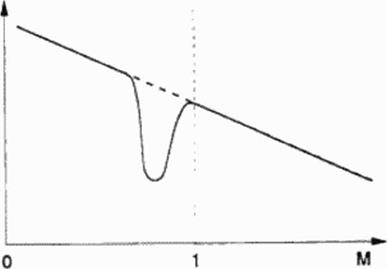Flutter
Concorde has inacccptable take-off noise levels. For a Concorde-type SCT lower noise levels can only be achieved using larger engine diameters and larger wing span. To maintain or even increase cruise performance, wing thickness will have to be reduced. Such wings become very flutter sensitive.
Aerodynamic damping is an indicator for flutter onset. It is the smaller, the higher the flight speed is. At high subsonic speeds, nonlinear transonic aerodynamics reduce aerodynamic damping, the so called transonic dip (Figure 33) (74). A new SCT has therefore to be investigated for flutter at transonic and supersonic cruise speeds.
 aerodynamic
aerodynamic
damping
Figure 33 Transonic Dip
Because of flutter becoming very critical for the thin wings of symmetric (Concorde – like) SCT-configurauons. at least a rough approximation of flutter tendencies must be included in the first steps of configuration optimisation. Hitherto nobody knows how to do it. Perhaps artificial flutter damping can help, if its certification becomes possible.











